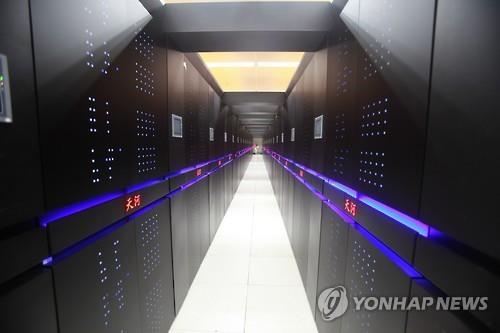Government to invest W100b to develop supercomputers
By Kim Young-wonPublished : April 4, 2016 - 15:39
The Korean government has rolled up its sleeves to develop more advanced supercomputing systems than AlphaGo after the artificial intelligence by Google’s DeepMind defeated the nation‘s human Go master last month.
Behind the learning and calculation prowess of AlphaGo are supercomputing systems made of more than 1,400 central processing and graphic processing units and application software.
Behind the learning and calculation prowess of AlphaGo are supercomputing systems made of more than 1,400 central processing and graphic processing units and application software.

The Ministry of Science, ICT and Future Planning announced Monday a plan to invest a total of 100 billion won ($87.2 million) -- approximately 10 billion won a year -- for the next 10 years to develop high-performance computers, or supercomputers, which will incorporate up-to-date system and application software.
The ICT Ministry will first develop a supercomputer that can manage 1 petaflop per second (a quadrillion calculations per second) in the first phase of the state-run project from this year through 2020, and then a supercomputer that can perform 30 quadrillion calculations, or faster, from 2021 to 2025.
China’s Tianhe-2, which has topped the global supercomputer list since 2010, boasts a performance of 33.86 petaflops, almost twice as fast as the runner-up Titan of the U.S.
The Korean ministry said it will combine dispersed government institutions and research centers for development of supercomputing systems to create a single control center.
The ministry had worked with academia, tech companies and experts, including Seoul National University, KAIST, SK hynix and Gluesys, to come up with the plan to vitalize the domestic supercomputer industry.
The state-run research institutes, the Electronics and Telecommunications Research Institute and the Korea Institute of Science and Technology Information developed Maha in 2015 and Baram in 2014, respectively. Seoul National University also developed supercomputer Chundoong in 2012. However, they have been outgunned by Chinese and U.S. peers, failing to make the world’s top 100.
Market research firm IDC forecast that the world’s supercomputing market and segments for relevant technologies, including servers, storage and software, will grow from $32.2 billion in 2014 to $43.4 billion in 2018 -- average annual growth of 7.8 percent.
Some industry officials said the government will have to put focus on providing well-balanced support for both hardware and software.
“Developing a fast computer is easy. The more important thing is to develop system and application software that can maximize computing power,” said Kwon Dae-seok, the chief of the AI and supercomputer developer Clunix.
“The amount of money that the ministry has promised to invest for supercomputing systems is not enough to grow both hardware and software for state-of-the-art supercompting systems,” he added.
The U.S., the long-term leader in supercomputing before being dethroned by China, has recently been pushing to regain its past glory as the forerunner in the global supercomputer segment.
U.S. President Barack Obama signed an executive order in July 2015 to operate a federal research, development and deployment project for the world’s first exascale (1,000-petaflop) computing system.
By Kim Young-won (wone0102@heraldcorp.com)







![[KH Explains] Hyundai's full hybrid edge to pay off amid slow transition to pure EVs](http://res.heraldm.com/phpwas/restmb_idxmake.php?idx=644&simg=/content/image/2024/04/18/20240418050645_0.jpg&u=20240419100350)






![[From the Scene] Monks, Buddhists hail return of remains of Buddhas](http://res.heraldm.com/phpwas/restmb_idxmake.php?idx=652&simg=/content/image/2024/04/19/20240419050617_0.jpg&u=20240419175937)

![[KH Explains] Hyundai's full hybrid edge to pay off amid slow transition to pure EVs](http://res.heraldm.com/phpwas/restmb_idxmake.php?idx=652&simg=/content/image/2024/04/18/20240418050645_0.jpg&u=20240419100350)

![[Today’s K-pop] Illit drops debut single remix](http://res.heraldm.com/phpwas/restmb_idxmake.php?idx=642&simg=/content/image/2024/04/19/20240419050612_0.jpg&u=)